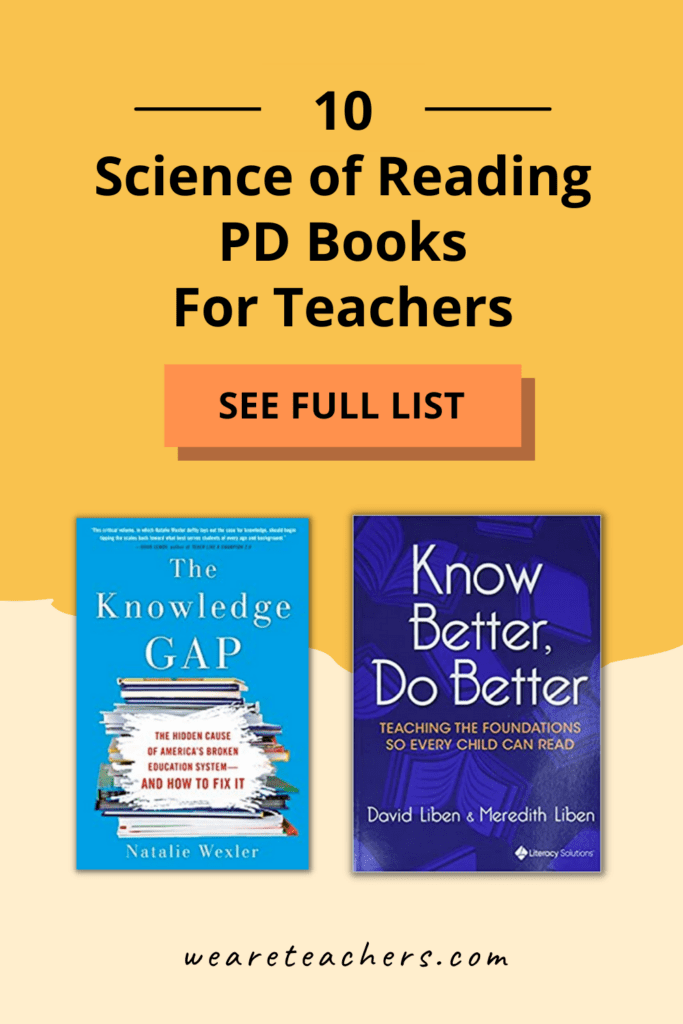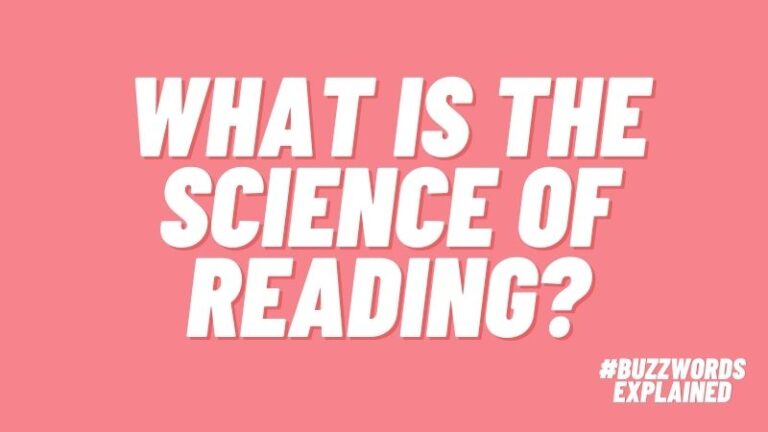What is the science of reading? The term is often used while discussing research-backed methods for teaching kids to read. It isn’t new, but it’s definitely a hot topic these days. If you’ve been wondering where to start learning more about the topic, we vetted some recent PD books that can help you out. We also know you’re busy, so we found a mix of quick reads you can get through in a weekend and ones that dive a little deeper.
(Just a heads up, WeAreTeachers may collect a share of sales from the links on this page.)
Science of Reading PD Books
1. Know Better Do Better: Teaching the Foundations So Every Child Can Read by David Liben and Meredith Liben
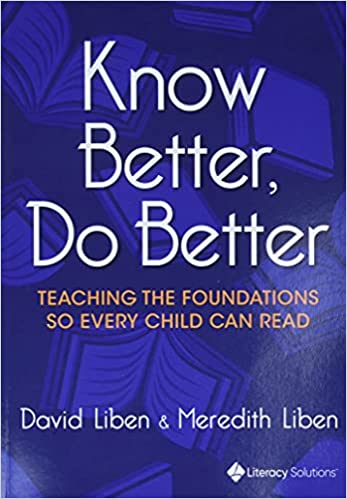
This is a super-practical primer (or refresher) on foundational literacy skills and how to teach them. The authors are founders of an alternative public school in New York City. They pulled off a dramatic turnaround in their students’ reading scores by leaning into the science of reading. The book includes many memorable stories that really help the content stick in your mind.
Buy it: Know Better Do Better: Teaching the Foundations So Every Child Can Read at Amazon | Know Better Do Better: Teaching the Foundations So Every Child Can Read at Bookshop
2. Shifting the Balance: 6 Ways to Bring the Science of Reading into the Balanced Literacy Classroom by Jan Burkins and Kari Yates

This book will help you rethink some of your balanced literacy classroom practices without feeling like you have to start from scratch. Each chapter calls out common misconceptions, explains research, and gives super-manageable suggestions for “making the shift.” Tons of teachers call it a game changer! (Psst: The authors have also have amazing online resources.)
Buy it: Shifting the Balance: 6 Ways to Bring the Science of Reading into the Balanced Literacy Classroom at Amazon | Shifting the Balance: 6 Ways to Bring the Science of Reading into the Balanced Literacy Classroom at Bookshop
3. Letter Lessons and First Words: Phonics Foundations That Work by Heidi Anne Mesmer
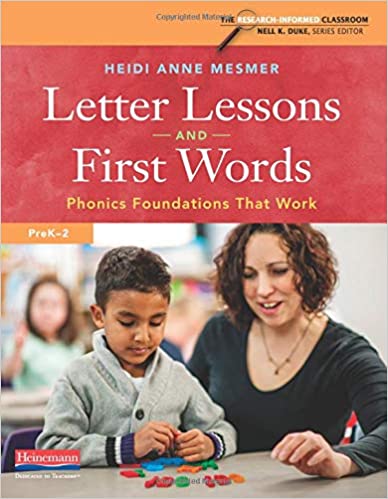
If you want to improve your grasp of phonics instruction, Heidi Mesmer definitely has your back. This book gives a crash course on the English language for teachers. (For example, if you constantly forget what a diphthong is, this one is for you!) There’s a helpful phonics lesson framework to use over and over. Plus, we love all the easy activities and routines.
Buy it: Letter Lessons and First Words: Phonics Foundations That Work at Amazon | Letter Lessons and First Words: Phonics Foundations That Work at Bookshop
4. The Reading Strategies Book: Your Everything Guide to Developing Skilled Readers by Jennifer Serravallo
Since 2015, we’ve pulled from this huge collection of strategies for helping students grow their reading comprehension, fluency, and reading response skills. In response to research, the author recently revised her chapter about reading accuracy. She added 30 additional decoding strategies and made it available as a free download for anyone who purchased the book. This updated chapter can help you double down on emphasizing decoding and discouraging guessing.
Buy it: The Reading Strategies Book: Your Everything Guide to Developing Skilled Reader at Amazon | The Reading Strategies Book: Your Everything Guide to Developing Skilled Reader at Bookshop
5. How to Plan Differentiated Reading Instruction, Second Edition: Resources for K-3 by Sharon Walpole and Michael C. McKenna
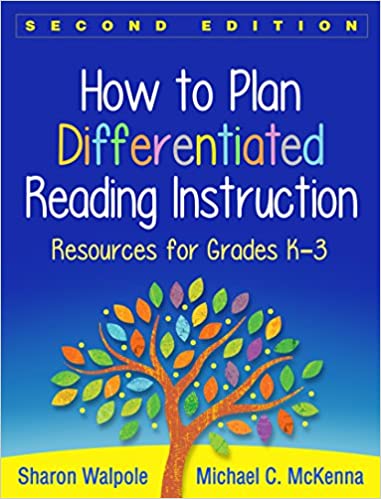
Juggling kids’ needs is tricky. In this book, chapters cover how to use research to plan small groups that target phonological awareness, word recognition and decoding, fluency, and comprehension. This updated edition is full of invaluable practical advice.
Buy it: How to Plan Differentiated Reading Instruction, Second Edition: Resources for K-3 at Amazon | How to Plan Differentiated Reading Instruction, Second Edition: Resources for K-3 at Bookshop
6. Choosing and Using Decodable Texts: Practical Tips for Enhancing Phonics Instruction by Wiley Blevins
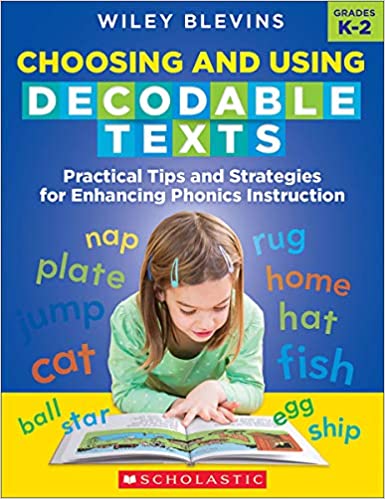
Do you hate decodable text? Long-time reading researcher Wiley Blevins just might win you over. Quick, readable, and research-driven, this is a great resource for K-2 teachers. Printable book lovers will appreciate the included black-line masters.
Buy it: Choosing and Using Decodable Texts: Practical Tips for Enhancing Phonics Instruction at Amazon | Choosing and Using Decodable Texts: Practical Tips for Enhancing Phonics Instruction at Bookshop
7. Sounding Out the Sight Words: An Alternative to Rote Memorization by Denise Eide and Cindy Kringelis
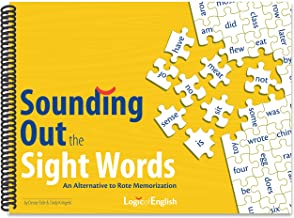
Here’s a science of reading PD book focused on one concrete action step. Brain research encourages teaching kids to rely on letter sounds to read high-frequency words. These lessons make it easy to update your approach.
Buy it: Sounding Out the Sight Words: An Alternative to Rote Memorization at Amazon
8. Speech to Print: Language Essentials for Teachers, Third Edition by Louisa Cook Moats

This gold-standard textbook from a reading research guru was recently updated. Now it has lots of practical guidance and helpful charts, too.
Buy it: Speech to Print: Language Essentials for Teachers, Third Edition at Amazon | Speech to Print: Language Essentials for Teachers, Third Edition at Bookshop
9. Language at the Speed of Sight: How We Read, Why So Many Can’t, and What Can Be Done About It by Mark Seidenberg

Fill your coffee mug and find your highlighters. This is a detailed explanation of the reading brain from a cognitive neuroscientist.
Buy it: Language at the Speed of Sight: How We Read, Why So Many Can’t, and What Can Be Done About It at Amazon | Language at the Speed of Sight: How We Read, Why So Many Can’t, and What Can Be Done About It at Bookshop
10. The Knowledge Gap: The Hidden Cause of America’s Broken Education System—and How to Fix It by Natalie Wexler

Here’s a science of reading PD book with a different perspective: the impact of background knowledge on students’ reading (and overall school) success. Do you want to be able to stick up for content area teaching for kids? If so, you’ll love this one.
Buy it: The Knowledge Gap: The Hidden Cause of America’s Broken Education System—and How to Fix It at Amazon | The Knowledge Gap: The Hidden Cause of America’s Broken Education System—and How to Fix It at Bookshop
What science of reading PD books have you read lately? Share in the comments below!
Want more booklists? Make sure to subscribe to our newsletters.
